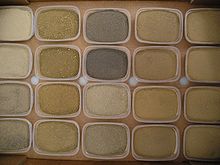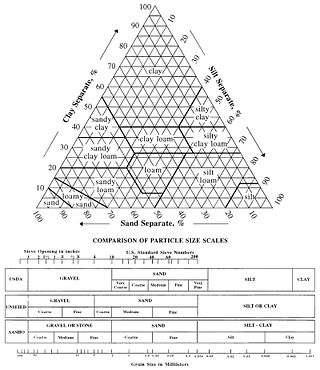
Soil classification
Did you know...
SOS Children has tried to make Wikipedia content more accessible by this schools selection. With SOS Children you can choose to sponsor children in over a hundred countries
Soil classification deals with the systematic categorization of soils based on distinguishing characteristics as well as criteria that dictate choices in use.
Overview
Soil classification is a dynamic subject, from the structure of the system itself, to the definitions of classes, and finally in the application in the field. Soil classification can be approached from the perspective of soil as a material and soil as a resource.
Engineering
Engineers, typically geotechnical engineers, classify soils according to their engineering properties as they relate to use for foundation support or building material. Modern engineering classification systems are designed to allow an easy transition from field observations to basic predictions of soil engineering properties and behaviors.
The most common engineering classification system for soils in North America is the Unified Soil Classification System (USCS). The USCS has three major classification groups: (1) coarse-grained soils (e.g. sands and gravels); (2) fine-grained soils (e.g. silts and clays); and (3) highly organic soils (referred to as " peat"). The USCS further subdivides the three major soil classes for clarification.
Other engineering soil classification systems in the States include the AASHTO Soil Classification System and the Modified Burmister (See biographical sketch of Prof. Donald Burmister ).
A full geotechnical engineering soil description will also include other properties of the soil including colour, in-situ moisture content, in-situ strength, and somewhat more detail about the material properties of the soil than is provided by the USCS code.
Soil science
For soil resources, experience has shown that a natural system approach to classification, i.e. grouping soils by their intrinsic property ( soil morphology), behaviour, or genesis, results in classes that can be interpreted for many diverse uses. Differing concepts of pedogenesis, and differences in the significance of morphological features to various land uses can affect the classification approach. Despite these differences, in a well-constructed system, classification criteria group similar concepts so that interpretations do not vary widely. This is in contrast to a technical system approach to soil classification, where soils are grouped according to their fitness for a specific use and their edaphic characteristics.
Natural system approaches to soil classification, such as the French Soil Reference System (Référentiel pédologique français) are based on presumed soil genesis. Systems have developed, such as USDA soil taxonomy and the World Reference Base for Soil Resources, which use taxonomic criteria involving soil morphology and laboratory tests to inform and refine hierarchical classes.
Another approach is numerical classification, also called ordination, where soil individuals are grouped by multivariate statistical methods such as cluster analysis. This produces natural groupings without requiring any inference about soil genesis.
In soil survey, as practiced in the United States, soil classification usually means criteria based on soil morphology in addition to characteristics developed during soil formation. Criteria are designed to guide choices in land use and soil management. As indicated, this is a hierarchical system that is a hybrid of both natural and objective criteria. USDA soil taxonomy provides the core criteria for differentiating soil map units. This is a substantial revision of the 1938 USDA soil taxonomy which was a strictly natural system. Soil taxonomy based soil map units are additionally sorted into classes based on technical classification systems. Land Capability Classes, hydric soil, and prime farmland are some examples.
In addition to scientific soil classification systems, there are also vernacular soil classification systems. Folk taxonomies have been used for millennia, while scientifically based systems are relatively recent developments.


